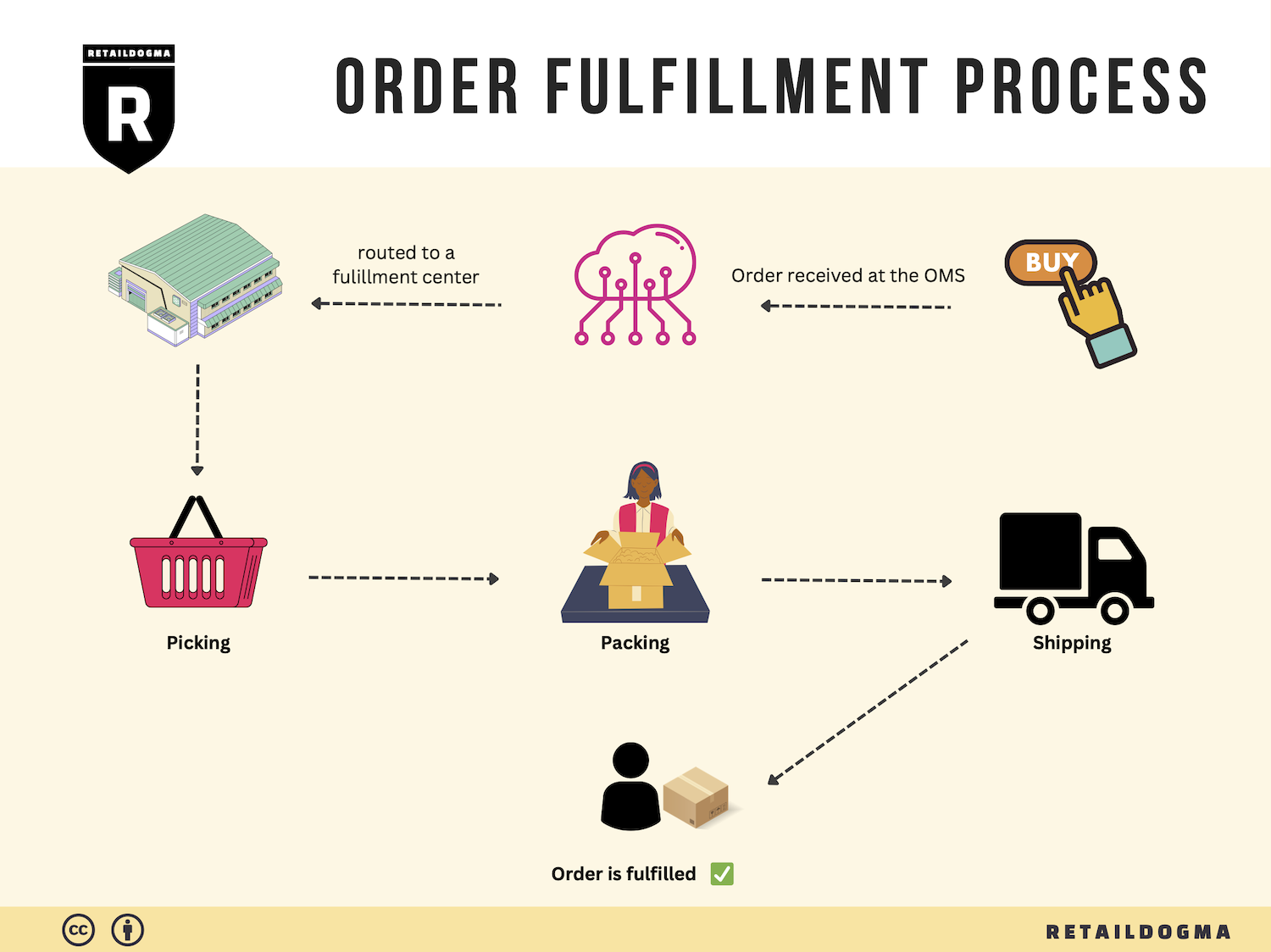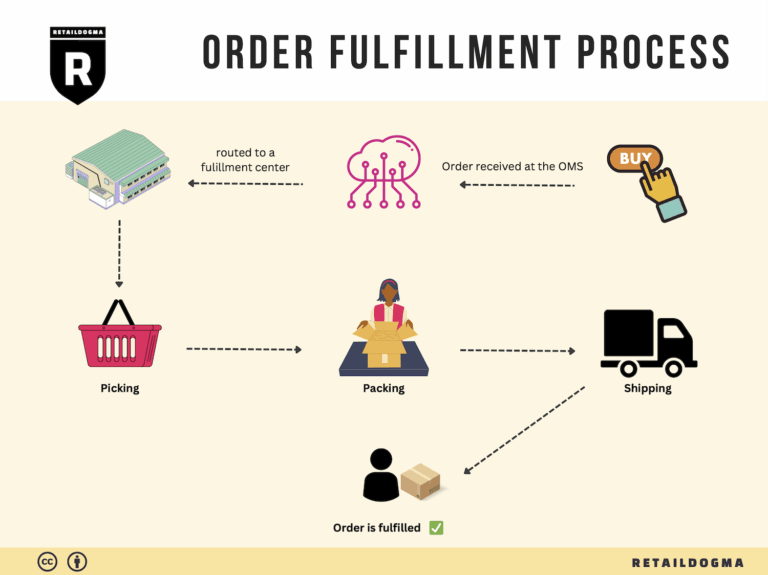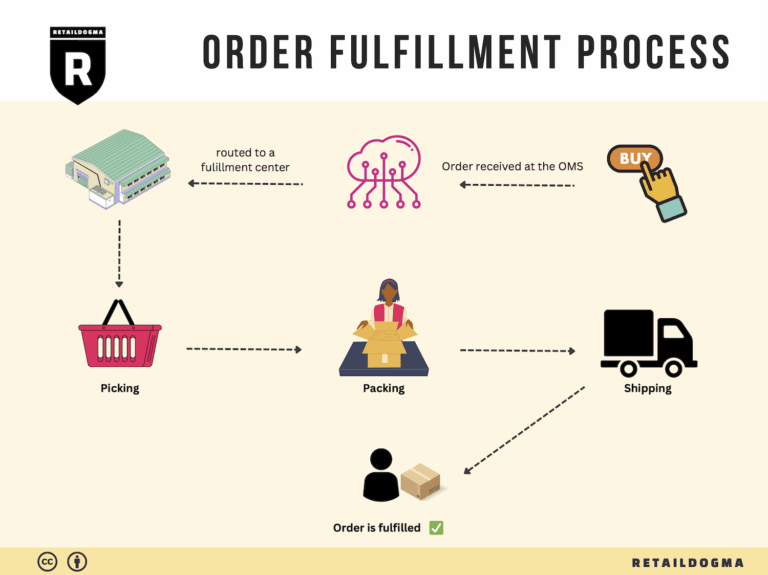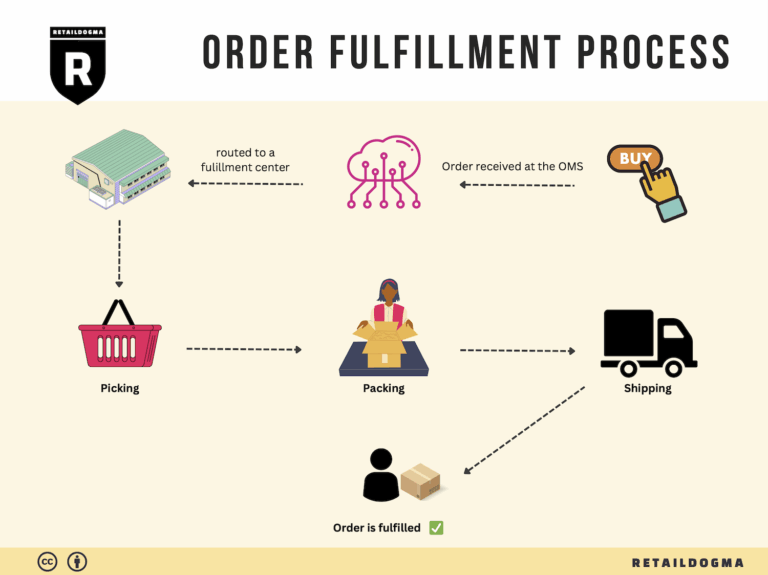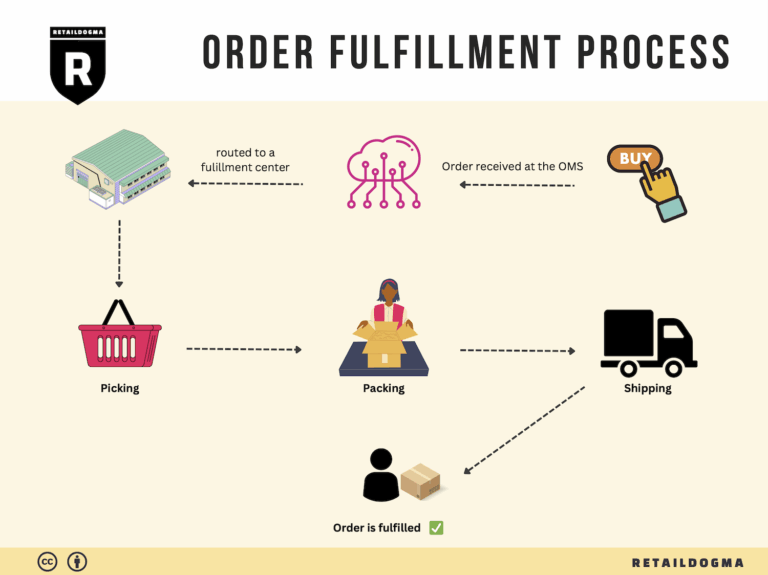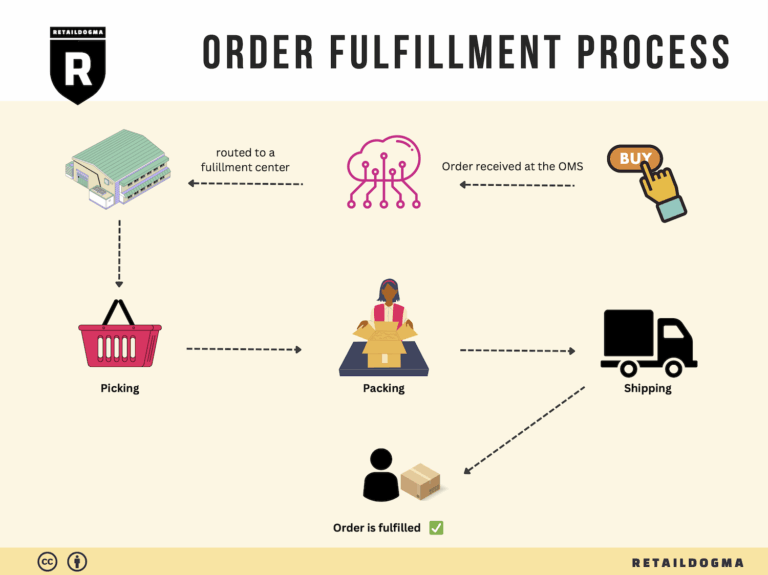How Order Fulfillment Works: A Step-by-Step Guide for Businesses
What is E-commerce Fulfillment? An Introduction for Growing Businesses
Understanding the Challenges of Order Fulfillment
As an e-commerce business owner, the excitement of scaling your sales can quickly turn into the stress of managing order fulfillment. Many growing online businesses find themselves overwhelmed by the logistics of packing, shipping, and tracking orders. This complexity can detract from your focus on product development and marketing, leading to missed opportunities and dissatisfied customers.
Defining E-commerce Fulfillment
At its core, e-commerce fulfillment is the process of getting a product from your warehouse or fulfillment center to your customer’s doorstep. This involves several steps, including inventory management, order processing, picking and packing, shipping, and handling returns. As your business grows, these tasks can become increasingly challenging, especially if you are still managing them in-house.
What This Guide Will Cover
This comprehensive guide aims to demystify e-commerce fulfillment by exploring various models and services available to businesses. We will delve into:
-
Fulfillment Models: Understanding different fulfillment options such as third-party logistics (3PL) and Fulfillment by Amazon (FBA), and how they can impact your operations.
-
Core Services: Outlining essential fulfillment services including inventory management, order processing, and shipping logistics, which are crucial for smooth operations.
-
Choosing the Right Partner: Providing insights into what to look for in a fulfillment partner, including their experience, technology capabilities, and customer service, to ensure that your logistics needs are met.
-
Pricing Structures: Discussing the various pricing models you might encounter, helping you evaluate costs and align them with your budget.

Empowering Your Business Decisions
The ultimate goal of this guide is to empower you to make informed decisions about your logistics strategy. By understanding the intricacies of e-commerce fulfillment, you can streamline your operations, enhance customer satisfaction, and ultimately foster growth in your business. With the right knowledge and tools, you can navigate the complexities of order fulfillment with confidence and focus on what you do best—growing your brand.
What You’ll Learn In This Guide
- What is E-commerce Fulfillment? An Introduction for Growing Businesses
- The Order Fulfillment Process: From ‘Buy’ Button to Customer’s Door
- Comparing Fulfillment Models: In-House vs. 3PL vs. Dropshipping
- A Deep Dive into Amazon FBA: Pros, Cons, and Who It’s For
- Core Services Offered by Fulfillment Centers
- How to Choose a Fulfillment Partner: A 6-Point Checklist
- Understanding Fulfillment Pricing: A Breakdown of Common Fees
- Frequently Asked Questions (FAQs) about Fulfillment
- Conclusion: Is Outsourcing Fulfillment the Right Move for Your Business?
- Important Disclaimer
The Order Fulfillment Process: From ‘Buy’ Button to Customer’s Door
1. Receiving Inventory
The order fulfillment process begins with receiving inventory from suppliers or manufacturers. This step involves checking the delivery against purchase orders to ensure that the correct items and quantities have been received. It’s crucial to record these items accurately into your inventory management system, utilizing key terms like SKU (Stock Keeping Unit) for each product.
Why is this step important? Proper receiving sets the foundation for the entire fulfillment process. Mistakes at this stage can lead to inventory discrepancies, stockouts, or excess inventory, which can ultimately affect customer satisfaction and operational efficiency. Efficient receiving processes reduce the time it takes to get products into the warehouse, allowing businesses to respond quickly to customer orders.
2. Warehouse Storage
Once inventory is received, the next step is warehouse storage. Products must be organized in a manner that maximizes space and facilitates easy access. This may involve categorizing items by type, size, or frequency of sale, and employing methods like FIFO (First In, First Out) to manage perishable goods or items with expiration dates.
Why is this step important? Effective warehouse storage optimizes space and reduces the time spent locating items during the picking process. A well-organized warehouse not only speeds up order fulfillment but also minimizes the risk of errors. Utilizing systems like warehouse management software (WMS) can enhance visibility into inventory levels, streamline operations, and improve overall productivity.
3. Order Picking
Order picking is the process of selecting products from the warehouse to fulfill customer orders. This step typically involves generating pick lists, which are documents that outline the specific items and quantities needed for each order. Picking methods can vary, including single order picking, batch picking, or zone picking, depending on the size of the operation and the volume of orders.
Why is this step important? Accurate picking is vital for maintaining customer satisfaction. Mistakes in this phase can lead to incorrect shipments, which can result in returns, additional shipping costs, and loss of customer trust. Implementing technologies such as barcode scanners or RFID systems can significantly reduce errors and improve picking speed, thereby enhancing overall efficiency.
4. Order Packing
After items have been picked, the next step is order packing. This involves assembling the selected items into packages, ensuring they are securely packed for transit. Key considerations during this stage include choosing the right packaging materials, including boxes, padding, and tape, as well as labeling packages correctly for shipping.
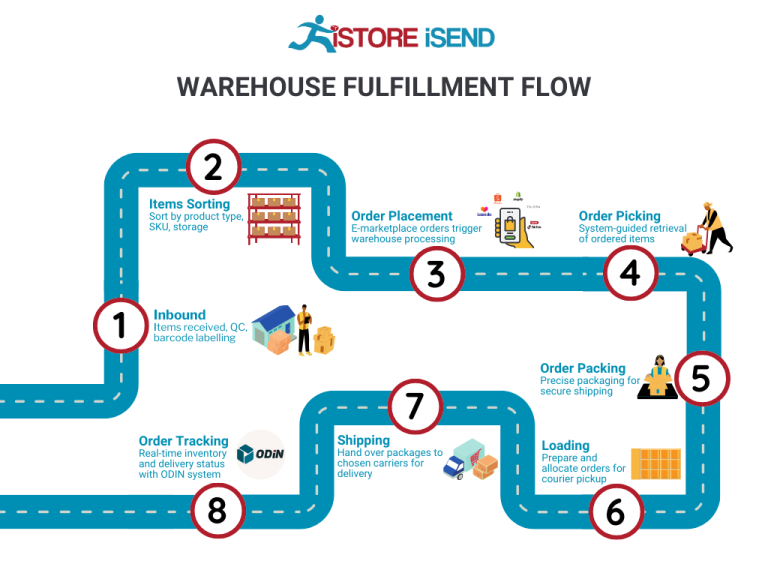
Why is this step important? Proper packing is essential to prevent damage during transit and to ensure that the correct items are sent to the customer. An effective packing process can also enhance the unboxing experience for customers, which is increasingly important in today’s competitive market. Utilizing packing slips and ensuring compliance with shipping regulations further streamline this process and minimize potential issues with carriers.
5. Shipping & Delivery
The final step in the order fulfillment process is shipping and delivery. This involves selecting the appropriate carrier based on factors such as cost, delivery speed, and destination. Once the order is shipped, tracking information is typically provided to the customer, allowing them to monitor their package in real-time.
Why is this step important? Timely and reliable shipping is a key determinant of customer satisfaction in e-commerce. Businesses must ensure they meet delivery promises, as delays can lead to dissatisfaction and lost sales. Additionally, leveraging third-party logistics (3PL) providers can help businesses scale their operations by managing shipping logistics more effectively, ensuring that products reach customers efficiently and cost-effectively.
Conclusion
In summary, the order fulfillment process is a multi-step operation that requires attention to detail at every stage, from receiving inventory to shipping and delivery. Each step is interconnected, and any inefficiencies can ripple through the entire process, affecting customer satisfaction and business performance. By focusing on each step and utilizing technology and best practices, e-commerce businesses can streamline their fulfillment operations, ultimately leading to growth and success in the competitive B2B landscape.
Comparing Fulfillment Models: In-House vs. 3PL vs. Dropshipping
Fulfillment Model Comparison
| Model | Who Handles Inventory | Best For (Business Stage) | Key Advantage | Key Disadvantage |
|---|---|---|---|---|
| In-House Fulfillment | The business itself | Startups to medium-sized firms | Full control over inventory and processes | High overhead costs and resource-intensive |
| Third-Party Logistics (3PL) | An external logistics provider | Growing businesses and scale-ups | Scalability and reduced operational complexity | Less control over inventory and potential costs |
| Dropshipping | Supplier or manufacturer | New entrepreneurs and small businesses | Low startup costs and no inventory risk | Lower profit margins and reliance on suppliers |
In-House Fulfillment
In-house fulfillment refers to managing all aspects of the fulfillment process within your own business. This model involves handling inventory storage, order processing, packaging, and shipping using your own resources and facilities. In-house fulfillment is typically best suited for startups to medium-sized firms that want full control over their operations. The key advantage of this model is the ability to maintain direct oversight of inventory management, quality control, and customer service. You can tailor processes to fit your specific needs and ensure that product handling meets your standards. However, this approach can lead to high overhead costs, including expenses related to warehousing, labor, and technology. Additionally, managing fulfillment in-house can be resource-intensive, requiring significant time and effort that could be better spent on core business activities like marketing and product development.
Third-Party Logistics (3PL)
Third-party logistics (3PL) involves outsourcing fulfillment operations to an external provider that specializes in logistics and supply chain management. This model is ideal for growing businesses and scale-ups that need to streamline their operations without sacrificing quality. The key advantage of using a 3PL is scalability; as your business grows, your 3PL can easily adapt to increased order volumes without the need for significant investment in infrastructure. Additionally, partnering with a 3PL can reduce operational complexity, allowing you to focus on your core business functions. However, a significant disadvantage is the loss of direct control over inventory management and fulfillment processes. You may also encounter potential hidden costs or fees, depending on the provider’s pricing structure, which can impact your overall profitability. Nonetheless, a well-chosen 3PL partner can enhance your operational efficiency and support your growth trajectory.
Dropshipping
Dropshipping is a fulfillment model where the retailer does not keep products in stock but instead transfers customer orders directly to a supplier or manufacturer, who then ships the products directly to the customer. This model is particularly appealing to new entrepreneurs and small businesses because it requires minimal upfront investment and eliminates the risks associated with holding inventory. The key advantage of dropshipping is the low startup cost and reduced financial risk, allowing entrepreneurs to enter the market with a broader range of products without significant capital. However, this model also has its drawbacks, primarily in terms of lower profit margins due to the reliance on suppliers for fulfillment. Additionally, dropshipping can lead to longer shipping times and less control over product quality and inventory levels, which can negatively impact customer satisfaction. Entrepreneurs must also be cautious about supplier reliability, as delays or errors on their part can reflect poorly on your business.
A Deep Dive into Amazon FBA: Pros, Cons, and Who It’s For
What is Fulfillment by Amazon (FBA)?
Fulfillment by Amazon (FBA) is a service provided by Amazon that allows e-commerce sellers to store their products in Amazon’s fulfillment centers. Amazon takes care of storage, packaging, and shipping of products, as well as handling customer service and returns. This means that when a customer orders a product, Amazon picks, packs, and ships the item directly to them, often providing fast shipping options like Amazon Prime.
FBA is designed to simplify the logistics of selling online, enabling sellers to focus on growing their business rather than managing the complexities of order fulfillment. By leveraging Amazon’s extensive logistics network, sellers can reach a vast audience while benefitting from Amazon’s trusted brand reputation.
How Does FBA Work?
-
Set Up Your FBA Account: Sellers need to create an Amazon Seller account and opt into the FBA program. This involves agreeing to Amazon’s terms and conditions and setting up shipping options.
-
Prepare Your Products: Products must be prepared according to Amazon’s guidelines, which include proper labeling and packaging to ensure items are ready for storage and shipment.
-
Ship Products to Amazon: Sellers send their products to Amazon’s designated fulfillment centers. Amazon provides shipping plans and addresses for sellers to use.
-
Storage: Once received, products are stored in Amazon’s warehouses. Inventory is tracked through the seller’s Amazon account.

-
Order Fulfillment: When a customer places an order for a product, Amazon takes over the fulfillment process. They pick the product from storage, pack it, and ship it directly to the customer.
-
Customer Service and Returns: Amazon manages customer service inquiries and processes returns on behalf of the seller, providing a seamless experience for buyers.
Pros of Using FBA
-
Prime Eligibility: Products fulfilled by Amazon are automatically eligible for Amazon Prime, which can significantly increase sales due to the appeal of fast, free shipping for Prime members.
-
Customer Trust: Selling through FBA leverages Amazon’s trusted brand. Customers are more likely to purchase from sellers who use FBA because they associate it with reliability and quality service.
-
Multi-Channel Fulfillment: FBA allows sellers to fulfill orders from other sales channels (such as eBay, Shopify, etc.) using Amazon’s logistics. This can streamline operations and reduce the complexity of managing multiple fulfillment processes.
-
Scalability: FBA provides a scalable solution for growing businesses. As demand increases, sellers can easily adjust their inventory levels without the need to invest in additional warehouse space or staff.
-
Access to Advanced Logistics: Sellers benefit from Amazon’s advanced logistics and supply chain management, including sophisticated tracking systems and optimized shipping routes.
Cons of Using FBA
-
High Fees: FBA comes with various fees, including storage fees for inventory and fulfillment fees for each item sold. These costs can add up, particularly for sellers with lower-priced items or high storage needs.
-
Strict Inventory Rules: Amazon has specific rules regarding inventory management, including performance metrics sellers must meet. Failure to comply can lead to penalties or account suspension.
-
Commingling Risks: FBA products may be commingled with similar products from other sellers. This can pose risks if a customer receives a damaged or inferior product, which could lead to negative reviews affecting the seller’s reputation.
-
Limited Control: While FBA handles many aspects of logistics, sellers relinquish a degree of control over inventory and fulfillment processes, which can be challenging for businesses that prefer to manage their operations closely.
-
Long-Term Storage Fees: If products remain unsold for an extended period, sellers may incur long-term storage fees, which can erode profit margins.
Who is FBA Best For?
Fulfillment by Amazon is best suited for a range of sellers, particularly:
-
Small to Medium-Sized Businesses: Those looking to scale quickly without the overhead of managing their own warehousing and logistics will find FBA to be a practical solution.
-
Brands with High Sales Volumes: Sellers with a high volume of sales can benefit from the economies of scale provided by FBA, allowing them to reduce shipping costs per item.
-
E-commerce Startups: New businesses looking to enter the market quickly can leverage FBA to gain access to a massive customer base without needing to establish their own fulfillment infrastructure.
-
Sellers of Seasonal Products: Businesses that sell seasonal items can take advantage of FBA’s flexibility, allowing them to ramp up inventory for peak seasons without the long-term commitment of a warehouse lease.
-
Multi-Channel Sellers: Those who sell on multiple platforms and wish to streamline their fulfillment processes can benefit from FBA’s multi-channel fulfillment capabilities.
In conclusion, while FBA offers numerous advantages that can significantly enhance an e-commerce seller’s operations, it is essential to consider the associated costs and limitations. By understanding the pros and cons, sellers can make an informed decision about whether FBA aligns with their business goals and operational needs.
Core Services Offered by Fulfillment Centers
Inventory Management & Warehousing
Inventory management and warehousing are foundational services provided by fulfillment centers that allow e-commerce businesses to efficiently store and track their products. Fulfillment centers offer sophisticated inventory management systems that integrate with your e-commerce platform, ensuring real-time visibility into stock levels. This capability is crucial for businesses to avoid stockouts or overstock situations, both of which can negatively impact sales and customer satisfaction.
By utilizing a fulfillment center’s inventory management services, businesses can benefit from accurate demand forecasting, automated inventory tracking, and streamlined reordering processes. These features help maintain optimal inventory levels, reduce carrying costs, and minimize waste. For example, when a product is nearing its reorder point, the system can automatically trigger a new order, ensuring that the business never runs out of popular items. Additionally, centralized warehousing enables businesses to consolidate their inventory in one location, simplifying logistics and reducing overhead costs associated with managing multiple storage sites.
Pick and Pack Services
Pick and pack services are essential for fulfilling orders efficiently. This process involves selecting the right items from the warehouse (picking) and packaging them appropriately for shipment (packing). Fulfillment centers employ trained staff and automated systems to optimize this process, ensuring that orders are fulfilled quickly and accurately.
The primary benefit of pick and pack services is the speed and accuracy with which orders can be processed. With fulfillment centers using advanced technology, such as barcode scanning and order management software, the risk of errors is significantly reduced. For e-commerce businesses, this translates into higher customer satisfaction, as orders are less likely to be incorrect or delayed. Moreover, fulfillment centers can handle varying order sizes, from single items to bulk orders, making them adaptable to the needs of different businesses. By outsourcing pick and pack services, e-commerce companies can focus on core business activities like marketing and product development, while leaving the logistics to experts.
Kitting and Assembly
Kitting and assembly services are particularly valuable for e-commerce businesses that sell products requiring bundling or configuration before shipping. This service involves grouping multiple items into a single kit or preparing products for assembly, which can include adding promotional materials or customizing orders for specific customers.
The benefit of kitting and assembly lies in the ability to offer unique product offerings and streamline the fulfillment process. For instance, if a business sells a gift basket that includes various items, fulfillment centers can assemble these baskets at their facility, reducing the time and labor required for the e-commerce business. This not only saves time but also enhances the customer experience by providing ready-to-ship products. Additionally, kitting services can help businesses manage seasonal demand more effectively, allowing for the rapid assembly of promotional kits during peak times without overwhelming internal resources.
Returns Management (Reverse Logistics)
Returns management, or reverse logistics, is a critical service offered by fulfillment centers that facilitates the processing of returned goods. This service encompasses everything from receiving returned items, inspecting them for quality, restocking them, and managing any necessary repairs or refurbishments.
For e-commerce businesses, an efficient returns management process is vital for maintaining customer satisfaction and loyalty. A streamlined return process can help reduce the friction associated with returns, making customers more likely to shop again. Fulfillment centers often provide online return portals, allowing customers to initiate returns easily and track their status. This transparency enhances the customer experience and builds trust.
Moreover, effective returns management can provide valuable insights into customer behavior and product performance. By analyzing return data, businesses can identify trends, such as common reasons for returns, which can inform product development and inventory strategies. This not only helps in reducing future returns but also contributes to more informed decision-making regarding product offerings.
Conclusion
In summary, fulfillment centers offer a range of core services that are essential for scaling e-commerce businesses. From inventory management and warehousing to pick and pack services, kitting and assembly, and returns management, these services are designed to enhance operational efficiency and customer satisfaction. By leveraging the expertise and technology of fulfillment centers, e-commerce businesses can focus on growth and innovation while ensuring their logistics operations run smoothly.
How to Choose a Fulfillment Partner: A 6-Point Checklist
Location & Warehouse Network
Importance:
The geographical location of your fulfillment partner’s warehouses significantly affects shipping costs and delivery times. A well-distributed warehouse network can help ensure faster delivery to your customers, which is crucial for maintaining customer satisfaction and loyalty.
Questions to Ask:
– Where are your warehouses located, and how does this align with our primary customer base?
– What shipping carriers do you work with, and how do they influence delivery times and costs?
– Can you provide insights into your average shipping times for different regions?
Technology & Integrations
Importance:
In the fast-paced world of e-commerce, having a robust technology stack is essential for seamless operations. A fulfillment partner should provide systems that integrate with your existing platforms (e.g., e-commerce, inventory management) to streamline processes and enhance visibility.
Questions to Ask:
– What technology do you use for order management, tracking, and reporting?
– Can your system integrate with our current e-commerce platform and inventory management software?
– Do you offer real-time tracking capabilities for both us and our customers?
Specializations (e.g., Cold Storage, Oversized Items)
Importance:
Different businesses have unique fulfillment needs, such as handling perishable goods, oversized items, or hazardous materials. Understanding your potential partner’s specializations can help ensure they can meet your specific requirements without compromising quality or compliance.
Questions to Ask:
– What types of products are you specialized in handling, and do you have the necessary facilities (like cold storage)?
– How do you ensure compliance with regulations for specialized items?
– Can you provide case studies or references from clients in similar industries?
Scalability & Capacity
Importance:
As your business grows, your fulfillment needs will evolve. A good fulfillment partner should have the capacity to scale operations accordingly, whether that means increasing storage space or handling a higher volume of orders without sacrificing service quality.
Questions to Ask:
– How do you manage fluctuations in order volume, especially during peak seasons?
– What strategies do you have in place for scaling operations?
– Can you provide metrics on your current capacity and any recent instances where you successfully scaled for a client?
Pricing and Contracts
Importance:
Understanding the pricing structure is critical for budgeting and financial forecasting. Look for transparency in pricing models, which should include all potential fees (e.g., storage, picking, shipping). Contracts should also be flexible enough to accommodate changes as your business evolves.
Questions to Ask:
– Can you break down your pricing model, including all associated fees?
– Are there minimum order requirements or long-term contracts, and what are the terms for termination?
– How do you handle price increases, and how frequently do they occur?
Customer Support & Reviews
Importance:
Reliable customer support is essential for resolving issues quickly and efficiently. Additionally, researching reviews and testimonials can provide valuable insights into the partner’s reliability and service quality.
Questions to Ask:
– What type of customer support do you offer (e.g., phone, email, chat), and what are your hours of operation?
– Can you provide references or case studies from current clients that speak to your customer service?
– How do you handle order issues, and what is your average response time for inquiries?
Conclusion
Choosing the right fulfillment partner is a pivotal decision that can influence the success of your e-commerce operations. By carefully evaluating potential partners using this checklist, you can ensure that your chosen provider aligns with your business goals, meets your logistical needs, and supports your growth strategy effectively. Always remember that the right partnership is not just about operational efficiency; it’s about building a collaborative relationship that can adapt to the changing landscape of your business.
Understanding Fulfillment Pricing: A Breakdown of Common Fees
Initial Setup Fees
Initial setup fees are typically charged when you first engage a fulfillment provider. These fees cover the costs associated with onboarding your business, which may include the configuration of your account, integration with your existing e-commerce platforms, and the establishment of operational processes tailored to your needs.
The calculation of initial setup fees can vary widely depending on the complexity of your business model. For instance, if your business requires custom packaging, specialized handling, or integration with multiple sales channels, the fees may be higher. It’s essential to discuss your specific needs with your fulfillment provider to get a clear understanding of what the initial setup will entail and how much it will cost.
Receiving Fees
Receiving fees are charged for the process of accepting and processing incoming inventory. These fees cover the labor and resources used to unload shipments, inspect products for damage, and input inventory into the warehouse management system.
Typically, receiving fees are calculated on a per-pallet or per-carton basis, depending on how your products are shipped. For example, if you send a shipment of ten pallets, you may incur a fee for each pallet received. It’s essential to clarify what is included in the receiving process, as some providers may charge additional fees for quality checks or restocking items that do not meet specifications.
Storage Fees (per pallet/bin)
Storage fees are charged for the space your inventory occupies within the fulfillment center. This fee is usually calculated on a monthly basis, either per pallet, per bin, or per cubic foot, depending on the storage method used by the provider.
The cost of storage can vary based on factors such as the location of the warehouse and the type of inventory. For instance, perishable goods may incur higher storage fees due to the need for climate control. Additionally, if your inventory fluctuates significantly, it’s important to discuss with your fulfillment partner whether there are minimum storage requirements or penalties for underutilized space.
Pick & Pack Fees (per item/order)
Pick and pack fees cover the labor involved in retrieving items from the warehouse and preparing them for shipment. This process includes picking the items, packing them securely, and labeling the packages for shipping.
These fees are generally charged on a per-item or per-order basis. For example, a fulfillment center might charge a standard fee for the first item in an order and an additional fee for each subsequent item. It’s important to understand the specific criteria that determine these fees, such as whether they include special packaging materials or require additional handling for fragile items.
Shipping Fees
Shipping fees are one of the most significant components of fulfillment pricing and vary based on several factors, including the shipping method (e.g., ground, expedited), destination (domestic vs. international), and the weight and dimensions of the packages.
Shipping fees can be calculated using a variety of pricing models, such as flat-rate shipping, weight-based shipping, or zone-based shipping, where costs increase depending on the distance to the delivery location. Some fulfillment providers may offer discounted shipping rates through partnerships with carriers, which can significantly reduce costs for your business. Understanding the various shipping options and associated costs is crucial for optimizing your logistics budget.
Tips for Getting an Accurate Quote
-
Be Transparent About Your Needs: Clearly outline your business model, order volume, and specific requirements to your potential fulfillment provider. This information will help them provide a tailored quote that reflects your unique situation.
-
Request a Detailed Breakdown: Ask for a comprehensive breakdown of all fees associated with their services. This should include initial setup fees, receiving fees, storage fees, pick and pack fees, and shipping fees.
-
Consider Volume Discounts: Inquire about potential discounts for high volume orders or long-term contracts. Many fulfillment centers offer tiered pricing structures that can lead to significant savings.
-
Evaluate Additional Services: Determine if the provider offers value-added services such as returns management, kitting, or custom packaging, and how these may affect your overall pricing.
-
Get Quotes from Multiple Providers: Compare quotes from several fulfillment centers to ensure you are getting a competitive rate. This will also give you a better understanding of the market rates for the services you require.
By understanding these common fulfillment pricing models and following these tips, you can better navigate the complexities of fulfillment costs and make informed decisions that support your business growth.
Frequently Asked Questions (FAQs) about Fulfillment
1. What is B2B fulfillment?
B2B fulfillment refers to the process of fulfilling orders from one business to another, rather than directly to consumers. It typically involves larger order quantities but less frequent purchases, often shipped via freight. This type of fulfillment is crucial for businesses that supply products to retailers, wholesalers, or other businesses.
2. How does B2B fulfillment differ from B2C fulfillment?
B2B fulfillment focuses on bulk orders with lower frequency, while B2C (business-to-consumer) fulfillment involves smaller, more frequent orders. B2B fulfillment often requires more complex logistics, compliance with industry regulations, and may involve EDI (electronic data interchange) for order management, unlike B2C, which is more straightforward.
3. What should I look for in a B2B fulfillment service provider?
When selecting a B2B fulfillment provider, consider their experience with B2B logistics, EDI compliance, inventory management capabilities, customer service responsiveness, and technology for order tracking. Ensure they can handle the specific requirements of your products and shipping needs.
4. How do shipping methods differ in B2B fulfillment?
B2B fulfillment often utilizes freight shipping due to the larger size and weight of orders, while B2C typically uses parcel shipping for smaller packages. The complexity of logistics increases with B2B orders, necessitating careful planning for shipping methods and costs.
5. What is the role of EDI in B2B fulfillment?
EDI, or electronic data interchange, allows businesses to exchange documents and transactions in a standardized electronic format. In B2B fulfillment, EDI streamlines order processing by automating the exchange of purchase orders, invoices, and shipping notices, thus enhancing efficiency and accuracy.
6. How do fulfillment costs vary between B2B and B2C?
Fulfillment costs for B2B can be higher due to larger shipment sizes and the need for specialized handling and shipping methods. Factors such as labor, storage, shipping distance, and order complexity can influence costs. B2C fulfillment typically incurs lower costs per order but may involve higher overall volume.
7. What is a fulfillment center?
A fulfillment center is a specialized warehouse designed to store inventory and process orders for e-commerce businesses. It handles the entire fulfillment process, including picking, packing, and shipping products directly to customers or other businesses, thereby allowing companies to focus on sales and marketing.
8. What is a 3PL, and how does it relate to B2B fulfillment?
A 3PL, or third-party logistics provider, is a company that offers logistics services to businesses, including warehousing, fulfillment, and transportation. In B2B fulfillment, partnering with a 3PL can help businesses scale operations, reduce costs, and improve efficiency by leveraging the provider’s expertise and resources.
9. How can I ensure timely delivery in B2B fulfillment?
To guarantee timely delivery, establish clear communication with your fulfillment provider regarding shipping schedules, compliance with regulations, and inventory levels. Implementing technology for real-time tracking and order management can also help maintain visibility throughout the supply chain.
10. How can I improve inventory management in B2B fulfillment?
Improving inventory management in B2B fulfillment involves utilizing technology for real-time tracking, demand forecasting, and automated reordering. Partnering with a fulfillment provider that offers robust inventory management tools can streamline your operations, reduce costs, and ensure you meet customer demand efficiently.
Conclusion: Is Outsourcing Fulfillment the Right Move for Your Business?
The Strategic Advantage of Outsourcing Fulfillment
Outsourcing your fulfillment operations can be a transformative decision for your business. One of the most significant benefits is the substantial time savings it offers. By delegating logistics tasks to a fulfillment partner, you free up valuable hours to focus on core business activities such as marketing, product development, and customer engagement. This allows you to enhance your overall operational efficiency and drive growth.
Scalability is another compelling reason to consider outsourcing. As your business expands, so do the complexities of managing inventory, shipping, and logistics. A proficient fulfillment partner can adapt to your evolving needs, handling everything from bulk orders to diverse shipping requirements without the hassle of scaling your internal operations. This flexibility ensures that you can meet customer demand without compromising service quality.
Additionally, leveraging the expertise of a fulfillment service can lead to improved accuracy and reliability in your supply chain. Experienced fulfillment providers understand the nuances of B2B logistics, including compliance with regulations and the intricacies of EDI systems. Their established networks can also result in cost savings through optimized shipping routes and bulk shipping rates, ultimately benefiting your bottom line.
However, it’s crucial to select the right fulfillment partner to support your growth trajectory. Take the time to evaluate potential providers based on their experience, technology capabilities, and customer service responsiveness.
As a strategic next step, consider conducting an audit of your current shipping processes. Are they efficient and cost-effective? Assessing these elements will help you determine whether outsourcing fulfillment is the right move for your business. By making informed choices now, you can position your business for sustainable success in the competitive e-commerce landscape.
Important Disclaimer
⚠️ Important Disclaimer
The information in this guide is for educational purposes. Fulfillment services, pricing, and platform features change frequently. Always conduct your own due diligence and consult with providers directly before making business decisions.
